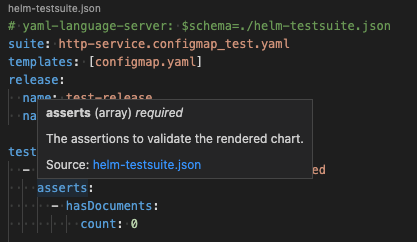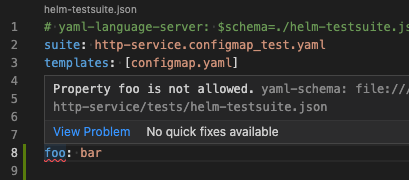Unit test for helm chart in YAML to keep your chart consistent and robust!
Feature:
- write test file in pure YAML
- render locally
- create nothing on your cluster
- wildcard selection for templates
- define values and release options
- snapshot testing
- test suite code completion and validation
If you are ready for writing tests, check the DOCUMENT for the test API in YAML.
- Install
- Docker Usage
- Get Started
- Test Suite File
- Usage
- Example
- Snapshot Testing
- Dependent subchart Testing
- Tests within subchart
- Test suite code completion and validation
- Frequently Asked Questions
- Related Projects / Commands
- Contributing
$ helm plugin install https://github.com/helm-unittest/helm-unittest.git
It will install the latest version of binary into helm plugin directory.
# run help of latest helm with latest helm unittest plugin
docker run -ti --rm -v $(pwd):/apps helmunittest/helm-unittest
# run help of specific helm version with specific helm unittest plugin version
docker run -ti --rm -v $(pwd):/apps helmunittest/helm-unittest:3.11.1-0.3.0
# run unittests of a helm 3 chart
# make sure to mount local folder to /apps in container
docker run -ti --rm -v $(pwd):/apps helmunittest/helm-unittest:3.11.1-0.3.0 .
# run unittests of a helm 3 chart with Junit output for CI validation
# make sure to mount local folder to /apps in container
# the test-output.xml will be available in the local folder.
docker run -ti --rm -v $(pwd):/apps helmunittest/helm-unittest:3.11.1-0.3.0 -o test-output.xml -t junit .
The docker container contains the fully installed helm client, including the helm-unittest plugin.
Add tests in .helmignore of your chart, and create the following test file at $YOUR_CHART/tests/deployment_test.yaml:
suite: test deployment
templates:
- deployment.yaml
tests:
- it: should work
set:
image.tag: latest
asserts:
- isKind:
of: Deployment
- matchRegex:
path: metadata.name
pattern: -my-chart$
- equal:
path: spec.template.spec.containers[0].image
value: nginx:latestand run:
$ helm unittest $YOUR_CHART
Now there is your first test! ;)
The test suite file is written in pure YAML, and default placed under the tests/ directory of the chart with suffix _test.yaml. You can also have your own suite files arrangement with -f, --file option of cli set as the glob patterns of test suite files related to chart directory, like:
$ helm unittest -f 'my-tests/*.yaml' -f 'more-tests/**/*.yaml' my-chartCheck DOCUMENT for more details about writing tests.
You may find yourself needing to set up a lots o tests that are a parameterization of a single test. For instance, let's say that you deploy to 3 environments env = dev | staging | prod.
In order to do this, you can actually write your tests as a helm chart as well. If you go about this route, you
must set the --chart-tests-path option. Once you have done so, helm unittest will run a standard helm render
against the values.yaml in your specified directory.
/my-chart
/tests-chart
/Chart.yaml
/values.yaml
/templates
/per_env_snapshots.yaml
/Chart.yaml
/values.yaml
/.helmignore
/templates
/actual_template.yaml
In the above example file structure, you would maintain a helm chart that will render out against the Chart.yaml that as provided and the values.yaml. With rendered charts, any test suite that is generated is automatically ran we do not look for a file postfix or glob.
Note: since you can create multiple suites in a single template file, you must provide the suite name, since we can no longer use the test suite file name meaningfully.
Note 2: since you can be running against subcharts and multiple charts, you need to make sure that you do not designate your --chart-tests-path to be the same folder as your other tests. This is because we will try to render those non-helm test folders and fail during the unit test.
Note 3: for snapshot tests, you will need to provide a helm ignore that ignores */__snapshot__/*. Otherwise, subsequent runs will try to render those snapshots.
The command for the above chart and test configuration would be:
helm unittest --chart-tests-path tests-chart my-chart$ helm unittest [flags] CHART [...]
This renders your charts locally (without tiller) and runs tests defined in test suite files.
--color enforce printing colored output even stdout is not a tty. Set to false to disable color
--strict strict parse the testsuites (default false)
-d --debugPlugin enable debug logging (default false)
-v, --values stringArray absolute or glob paths of values files location to override helmchart values
-f, --file stringArray glob paths of test files location, default to tests\*_test.yaml (default [tests\*_test.yaml])
-q, --failfast direct quit testing, when a test is failed (default false)
-h, --help help for unittest
-t, --output-type string the file-format where testresults are written in, accepted types are (JUnit, NUnit, XUnit) (default XUnit)
-o, --output-file string the file where testresults are written in format specified, defaults no output is written to file
-u, --update-snapshot update the snapshot cached if needed, make sure you review the change before update
-s, --with-subchart charts include tests of the subcharts within charts folder (default true)
--chart-tests-path string the folder location relative to the chart where a helm chart to render test suites is located
Now JsonPath is supported for mappings and arrays.
This makes it possible to find items in an array, based on JsonPath.
For more detail on the jsonPath syntax.
Due to the change to JsonPath, the map keys in path containing periods (.) or special characters (/) are now supported with the use of "":
- equal:
path: metadata.annotations["kubernetes.io/ingress.class"]
value: nginxThe next releases it will be possible to validate multiple paths when JsonPath result into multiple results.
The test job or assertion can also specify a documentSelector rather than a documentIndex. Note that the documentSelector will always override a documentIndex if a match is found. This field is particularly useful when helm produces multiple templates and the order is not always guaranteed.
The path in the documentSelector has Yaml JsonPath Support, using JsonPath expressions it is possible to filter on multiple fields.
The value in the documentSelector can validate complete yaml objects.
...
tests:
- it: should pass
values:
- ./values/staging.yaml
set:
image.pullPolicy: Always
resources:
limits:
memory: 128Mi
template: deployment.yaml
documentSelector:
path: metadata.name
value: my-service-name
asserts:
- equal:
path: metadata.name
value: my-deployCheck test/data/v3/basic/ for some basic use cases of a simple chart.
Sometimes you may just want to keep the rendered manifest not changed between changes without every details asserted. That's the reason for snapshot testing! Check the tests below:
templates:
- templates/deployment.yaml
tests:
- it: pod spec should match snapshot
asserts:
- matchSnapshot:
path: spec.template.spec
# or you can snapshot the whole manifest
- it: manifest should match snapshot
asserts:
- matchSnapshot: {}The matchSnapshot assertion validate the content rendered the same as cached last time. It fails if the content changed, and you should check and update the cache with -u, --update-snapshot option of cli.
$ helm unittest -u my-chart
The cache files is stored as __snapshot__/*_test.yaml.snap at the directory your test file placed, you should add them in version control with your chart.
If you have hard dependency subcharts (installed via helm dependency) existed in charts directory (they don't need to be extracted), it is possible to unittest these from the root chart. This feature can be helpful to validate if good default values are accidentally overwritten within your default helm chart.
# $YOUR_CHART/tests/xxx_test.yaml
templates:
- charts/postgresql/templates/xxx.yaml
tests:
- it:
set:
# this time required to prefix with "postgresql."
postgresql.somevalue: should_be_scoped
asserts:
- ...Note 1: if dependent subcharts uses an alias, use the alias name in the templates. Note 2: using the folder structure in templates can also be used to unittest templates which are placed in subfolders or unittest subcharts from the rootchart.
Check test/data/v3/with-subchart/ as an example.
If you have customized hard dependency subchart (not installed via helm dependency, but added manually) existed in charts directory, tests inside would also be executed by default. You can disable this behavior by setting --with-subchart=false flag in cli, thus only the tests in root chart will be executed. Notice that the values defined in subchart tests will be automatically scoped, you don't have to add dependency scope yourself:
# with-subchart/charts/child-chart/tests/xxx_test.yaml
templates:
- templates/xxx.yaml
tests:
- it:
set:
# no need to prefix with "child-chart."
somevalue: should_be_scoped
asserts:
- ...Check test/data/v3/with-subchart/ as an example.
Most popular IDEs (IntelliJ, Visual Studio Code, etc.) support applying schemas to YAML files using a JSON Schema. This provides comprehensive documentation as well as code completion while editing the test-suite file:
In addition, test-suite files can be validated while editing so wrongfully added additional properties or incorrect data types can be detected while editing:
When developing with VSCode, the very popular YAML plug-in (created by RedHat) allows adding references to schemas by adding a comment line on top of the file:
# yaml-language-server: $schema=https://raw.githubusercontent.com/helm-unittest/helm-unittest/main/schema/helm-testsuite.json
suite: http-service.configmap_test.yaml
templates: [configmap.yaml]
release:
name: test-release
namespace: TEST_NAMESPACEAlternatively, you can add the schema globally to the IDE, using a well defined pattern:
"yaml.schemas": {
"https://raw.githubusercontent.com/helm-unittest/helm-unittest/main/schema/helm-testsuite.json": ["charts/*/tests/*_test.yaml"]
}Similar to VSCode, IntelliJ allows mapping file patterns to schemas via preferences: Languages & Frameworks -> Schemas and DTDs -> JSON Schema Mappings
As more people use the unittest plugin, more questions will come. Therefore a Frequently Asked Question page is created to answer the most common questions.
If you are missing an answer to a question, feel free to raise a ticket.
This plugin is inspired by helm-template, and the idea of snapshot testing and some printing format comes from jest.
And there are some other helm commands you might want to use:
-
helm template: render the chart and print the output. -
helm lint: examines a chart for possible issues, useful to validate chart dependencies. -
helm test: test a release with testing pod defined in chart. Note this does create resources on your cluster to verify if your release is correct. Check the doc.
Alternatively, you can also use generic tests frameworks:
MIT
Issues and PRs are welcome! Before start developing this plugin, you must have Go >= 1.21 installed, and run:
git clone [email protected]:helm-unittest/helm-unittest.git
cd helm-unittest
And please make CI passed when request a PR which would check following things:
gofmtno changes needed. Please rungofmt -w -s .before you commit.go test ./pkg/unittest/...passed.
In some cases you might need to manually fix the tests in *_test.go. If the snapshot tests (of the plugin's test code) failed, you need to run:
UPDATE_SNAPSHOTS=true go test ./...
This update the snapshot cache file and please add them before you commit.


